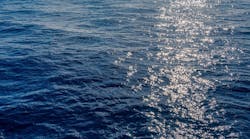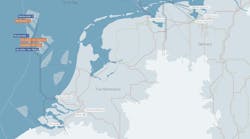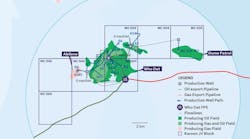Jeremy Beckman • London
Upstream investment on the Norwegian shelf could reach a new peak this year of NOK 150 billion ($25.6 billion), according to the Norwegian Petroleum Directorate (NPD). The forecast increase (up from NOK 130 billion, or $22.2 billion, in 2010) is due largely to major new projects swinging into action, such as Statoil’s Gudrun and Valemon in the North Sea. But NPD also sees worrying indicators, with discoveries failing to offset falling production.
Charts shows wells drilled by operators on the Norwegian shelf during 2010 (Source: Norwegian Petroleum Directorate).
Over the short term, the outlook remains healthy, with investments set to continue climbing through 2013. This year, NPD expects more development plans to be submitted, headed by ConocoPhillips’ proposals for Ekofisk Sor and Eldfisk II in the southern North Sea. Both will feature new production platforms. Others in line for platforms are Total’s Hild oil field, following a successful delineation well last year, and Lundin’s Luno and Det norske oljeselskap’s Draupne, which could be developed jointly. Last month, BG put forward plans to produce its smaller Jordbaer discovery via a chartered FPSO, and could do the same later this year for its Bream field in the North Sea.
During 2010, Norwegian operators completed 41 exploration and appraisal wells, NPD says, of which 16 were discoveries. Most were small-mid-size finds close to production complexes in the North Sea and Norwegian Sea, with only one wildcat in the Barents Sea. The most active drillers were Statoil and Det Norske (nine wells each). This year NPD anticipates 50-55 exploratory well spuds across the shelf.
The major disappointment in 2010 was Norske Shell’s appraisal of the Gro gas discovery in the deepwater Norwegian Sea, and its dry hole on the Dalsnuten prospect in the same sector. These results, coupled with new surveys of unexplored offshore regions farther north, caused NPD to cut its estimate of Norway’s undiscovered resources from 3.3 to 2.6 bcmoe.
Last year, Norwegian fields delivered 229.5 MMcmoe of production, 4% down on the figure for 2009, and NPD foresees further steady decline through 2015. Director Bente Nyland called for new measures to halt the downward drift, including increased development of mature fields.
Snohvit could provide further LNG feedstock
Statoil and its partners in the Snohvit license in the Barents Sea may build a second train at the Hammerfest LNG plant on Melkoya Island. Expanding capacity could accelerate production of gas in the area and of reserves yet to be discovered. This would trigger further offshore development, including new production wells, subsea templates, and a second gas export pipeline.
Feasibility studies are under way, but the new plant is unlikely to come onstream before 2018. The existing facilities handle supplies from the Snohvit field, which are sent to Melkoya via a 143-km (89-mi) subsea pipeline. Currently, Train 1 produces 13,000 t/d of LNG, 900 t/d of LPG and 2,000 t/d of condensate.
UK to toughen offshore inspections
Industry Association Oil & Gas UK welcomed the decision by Britain’s government to reject a moratorium on drilling in UK waters, following investigations into theDeepwater Horizon/Macondo oil spill. Chief Executive Malcolm Webb said any suspension of activity would be unnecessary and would undermine the UK’s energy security.
The government’s Energy and Climate Change Committee, in its report into UK deepwater drilling, concluded that Britain’s regulatory regime was stricter than its counterpart in the US Gulf of Mexico. However, the authors did issue recommendations and observations that Oil & Gas UK did not agree with, notably the need for two sets of blind shear rams on BOPs, and a perceived lack of clarity concerning liability for offshore incidents.
However, the government has decided to step up its program of inspections on UK offshore installations. It will recruit more specialist staff to implement 150 annual environmental inspections taking in all manned, fixed installations and around 24 drilling rigs. And it will allocate two inspectors instead of the present one for installations involved in deepwater or complex offshore programs. The requirement for increased inspections was first proposed last September by US Secretary of the Interior Ken Salazar, and later included in last month’s report by the US National Commission on Macondo.
The UK government said it would review Britain’s oil and gas offshore regulatory regime in the light of the US investigations. This work will be undertaken by the Department of Energy and Climate Change, the Health & Safety Executive, and the Marine Coast Guard Agency, and will take into account the full life cycle of an offshore development.
UK drilling levelling off
Deloitte’s Petroleum Services Group in Aberdeen counted 71 exploratory and appraisal well spuds on the UK shelf last year. Although this represented a drop of 9% on 2009, the total was consistent with levels seen during most of the past decade, according to energy partner Graham Hollis. Deloitte says well numbers may rise in 2011 if oil prices stay high, making more technically challenging drilling projects viable.
This year, there have already been two confirmed discoveries. West of Shetland, Total proved gas in the Edradour prospect, close to its emerging Laggan-Tormore gas/condensate export facilities. In the Central North Sea, EnCore found oil in the Varadero structure, near last year’s Catcher discovery. Farther north, Xcite Energy suspended its 9/3b-6z horizontal appraisal well on the Bentley heavy oil field, following a successful flow test. The well will be available for re-use in a full field development.
PAR gains German foothold
Swedish company PA Resources (PAR) has been awarded an exploration license offshore Schleswig-Holstein in northern Germany. The B20008-73 concession is adjacent to PAR’s Danish North Sea license 12/06, where two wells will be drilled later in the year, with similar objectives to prospect targets in the German permit.
Among other leasing developments in Western Europe, Faroe Petroleum has agreed to acquire Nexen’s 28% stake in the undeveloped Perth oil field, 185 km (115 mi) northeast of Aberdeen in block 15/21c. Faroe is working with new operator Deo Petroleum to address technical challenges of the development, which could be tied back to nearby Tartan or Scott platforms.
In the Rockall basin off Western Ireland, OMV has agreed to offload its 50% interest in License 3/05 to San Leon Energy for $5 million. The acreage includes the Killala and Kingfisher prospects. Assuming the transaction is approved, San Leon will seek to bring in other farm-in partners to this and its other licenses in the Irish Atlantic margin.
Offshore Articles Archives
View Oil and Gas Articles on PennEnergy.com






